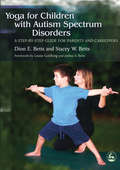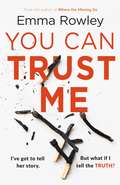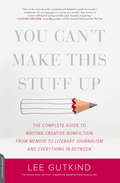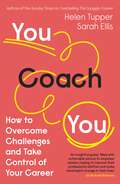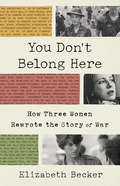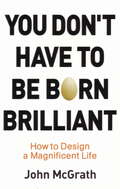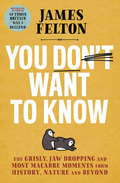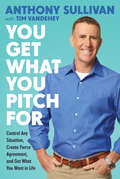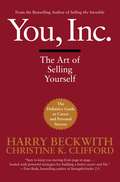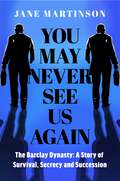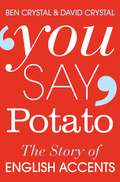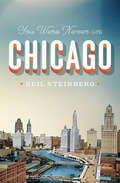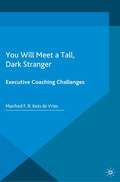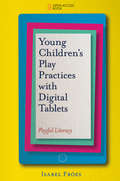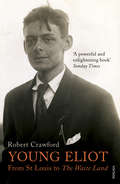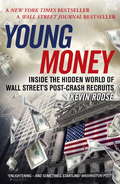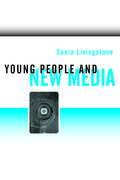- Table View
- List View
Yoga for Children with Autism Spectrum Disorders: A Step-by-Step Guide for Parents and Caregivers (PDF)
by Dion Betts Stacey W. BettsHaving successfully used yoga to combat the stress of their own busy lives, Dion and Stacey Betts discovered its potential for their son Joshua, who has Asperger Syndrome. This fully-illustrated book combines the authors' professional expertise with their experience of parenting, offering a range of gentle and fun yoga positions and breathing techniques that are effective in dealing with the increased levels of anxiety, disorientation and tactile sensitivity often found in children with autism spectrum disorders (ASDs). The authors give step-by-step descriptions of warming-up, strengthening, calming, and tension-releasing exercises that are suitable for reducing coping mechanisms, such as hand-flapping, and increasing muscle tone, muscle strength and body awareness. They also offer a range of short and long sequences that can be tailored to fit the needs of the individual child. Yoga for Children with Autism Spectrum Disorders is ideal for parents and caregivers who want to use simple yoga techniques to help children with ASDs overcome some of the symptoms of the disorder.
Yoga for Children with Autism Spectrum Disorders: A Step-by-Step Guide for Parents and Caregivers
by Stacey W. Betts Dion BettsHaving successfully used yoga to combat the stress of their own busy lives, Dion and Stacey Betts discovered its potential for their son Joshua, who has Asperger Syndrome. This fully-illustrated book combines the authors' professional expertise with their experience of parenting, offering a range of gentle and fun yoga positions and breathing techniques that are effective in dealing with the increased levels of anxiety, disorientation and tactile sensitivity often found in children with autism spectrum disorders (ASDs). The authors give step-by-step descriptions of warming-up, strengthening, calming, and tension-releasing exercises that are suitable for reducing coping mechanisms, such as hand-flapping, and increasing muscle tone, muscle strength and body awareness. They also offer a range of short and long sequences that can be tailored to fit the needs of the individual child. Yoga for Children with Autism Spectrum Disorders is ideal for parents and caregivers who want to use simple yoga techniques to help children with ASDs overcome some of the symptoms of the disorder.
You Can Trust Me: The gripping psychological thriller from the author of WHERE THE MISSING GO
by Emma RowleyThe gripping psychological thriller full of twists and turns, from the bestselling author of WHERE THE MISSING GO - for fans of FOUND by Erin Kinsley, ALL THE RAGE by Cara Hunter and THE FAMILY UPSTAIRS by Lisa Jewell.*****************You can trust me.But can I trust you?Olivia is the domestic goddess who has won millions of followers by sharing her picture-perfect life online. And now she's releasing her tell-all autobiography.For professional ghostwriter Nicky it's the biggest job of her career. But as she delves deeper into Olivia's life, cracks begin to appear in the glamorous façade. From the strained relationship with her handsome husband, to murky details of a tragic family death in her childhood, the truth belies Olivia's perfect public image.But why is Olivia so desperate to leave an old tragedy well alone? And how far will she go to keep Nicky from the truth?*****************'Emma Rowley has created a nightmare scenario which is all too plausible' - RACHEL ABBOTT, author of THE SIXTH WINDOW'A taut, twisty and tension-packed thriller about the depths of obsession and the strength of love' - CARA HUNTER, no.1 bestselling author of CLOSE TO HOME'A deliciously dark & emotive debut with an extremely powerful ending' - MEL SHERRATT, author of SHE DID ITIf you like Clare Mackintosh, Fiona Barton, Teresa Driscoll, Jenny Blackhurst, Rachel Abbott, Laura Marshall, Joy Ellis, Cara Hunter, Mel Sherratt or Lisa Jewell then you will be utterly gripped by this psychological thriller with a massive twist you won't see coming.WHY READERS ARE GIVING EMMA ROWLEY'S THRILLERS *FIVE STARS*:'My favourite book of this year''BRILLIANT''WOW! WOW!''You simply do not know how this twisting turning tale will turn out''Amazingly gripping''I envy anyone who is yet to read it''Wow! That was intense.''From the very first page I was gripped''A fantastic book written with so much sensitivity''I absolutely loved every twisted page''Heart wrenching''I loved this book''10/10''The pace and prose flowed so clearly and masterfully''It's so well written it was an absolute gift to read''A mother's love is unlike any other and it is perfectly captured within these pages''You will thoroughly love this book''A pure delight to read''I was immediately intrigued with both the title & the description. The book didn't let me down'
You Can't Make This Stuff Up: The Complete Guide to Writing Creative Nonfiction--from Memoir to Literary Journalism and Everything in Between
by Lee GutkindFrom "the godfather behind creative nonfiction" (Vanity Fair) comes this indispensable how-to for nonfiction writers of all levels and genres, "reminiscent of Stephen King's fiction handbook On Writing" (Kirkus). Whether you're writing a rags-to-riches tell-all memoir or literary journalism, telling true stories well is hard work. In You Can't Make This Stuff Up, Lee Gutkind, the go-to expert for all things creative nonfiction, offers his unvarnished wisdom to help you craft the best writing possible. Frank, to-the-point, and always entertaining, Gutkind describes and illustrates every aspect of the genre. Invaluable tools and exercises illuminate key steps, from defining a concept and establishing a writing process to the final product. Offering new ways of understanding the genre, this practical guidebook will help you thoroughly expand and stylize your work.
You Can't Make This Stuff Up: The Complete Guide to Writing Creative Nonfiction -- from Memoir to Literary Journalism and Everything in Between
by Lee GutkindFrom "the godfather behind creative nonfiction" (Vanity Fair) comes this indispensable how-to for nonfiction writers of all levels and genres, "reminiscent of Stephen King's fiction handbook On Writing" (Kirkus). Whether you're writing a rags-to-riches tell-all memoir or literary journalism, telling true stories well is hard work. In You Can't Make This Stuff Up, Lee Gutkind, the go-to expert for all things creative nonfiction, offers his unvarnished wisdom to help you craft the best writing possible. Frank, to-the-point, and always entertaining, Gutkind describes and illustrates every aspect of the genre. Invaluable tools and exercises illuminate key steps, from defining a concept and establishing a writing process to the final product. Offering new ways of understanding the genre, this practical guidebook will help you thoroughly expand and stylize your work.
You Coach You: How to Overcome Challenges and Take Control of Your Career
by Helen Tupper Sarah Ellis'What I love about this book is that it gives us the tools to guide ourselves and know that change and our true value is within us all' Mary PortasOur careers are full of potential and possibilities, uncertainty and change. There is no such thing as a straight line to success and there are times when we get stuck, face obstacles, feel frustrated or want to explore new opportunities. In these moments the best place to start is by coaching yourself. No one can solve your problems better than you can, and learning to coach yourself will accelerate your self-awareness and help you take control of your career. In You Coach You, you'll learn the mindset, skillset and toolkit you need to coach yourself. You'll discover practical support on some of the most common coaching challenges including:- Exploring your progression possibilities and making them happen- Building your resilience reserves and turning adversity into action- Moving beyond busy to time well spent and finding the right work-life fit for you- Building the beliefs that help you succeed and overcoming setbacks- Creating the connections you need for your career and fixing friction in difficult relationships- Developing a sense of direction and a purpose that is motivating and meaningful for youPacked with ideas for action and insightful tools, this practical book will help you to get unstuck, and increase your confidence in and control over your career.If you enjoyed reading this, check out The Squiggly Career, Helen and Sarah's Sunday Times no. 1 bestselling guide to supercharging your confidence, playing to your strengths and setting yourself up for success.
You Don't Belong Here: How Three Women Rewrote the Story of War
by Elizabeth BeckerThe long-buried story of three extraordinary female journalists who permanently shattered the barriers to women covering war. Kate Webb, an Australian iconoclast, Catherine Leroy, a French daredevil photographer, and Frances FitzGerald, a blue-blood American intellectual, arrived in Vietnam with starkly different life experiences but one shared purpose: to report on the most consequential story of the decade. At a time when women were considered unfit to be foreign reporters, Frankie, Catherine, and Kate challenged the rules imposed on them by the military, ignored the belittlement of their male peers, and ultimately altered the craft of war reportage for generations. In You Don&’t Belong Here, Elizabeth Becker uses these women&’s work and lives to illuminate the Vietnam War from the 1965 American buildup, the expansion into Cambodia, and the American defeat and its aftermath. Arriving herself in the last years of the war, Becker writes as a historian and a witness of the times. What emerges is an unforgettable story of three journalists forging their place in a land of men, often at great personal sacrifice. Deeply reported and filled with personal letters, interviews, and profound insight, You Don&’t Belong Here fills a void in the history of women and of war.
You Don't Have to Be Born Brilliant: How to Design a Magnificent Life
by John McGrathWhy is it that a handful of the population achieve phenomenal results and the majority struggle to keep their heads above water? They might have the same circumstances and same sorts of opportunities, yet the results can be radically different.Real success is something that eludes most of us, but it doesn't have to. In a world so full of opportunities it is within everyone's power to turn their life around. Whether in our career, relationships, health or finances, John McGrath believes we are all capable of seizing opportunties and turning failure into advantage if we change our attitude: attitude is everything. You Don't Have To Be Born Brilliant is about achieving magnificence in every area of your life.
You Don't Want to Know: The grisly, jaw-dropping and most macabre moments from history, nature and beyond
by James FeltonWith his trademark brand of bulldozer-banter, Twitter legend James Felton guides you through the most morbidly fascinating facts you'll then wish you could forget. Ever wondered why the chainsaw was invented?* How authorities dealt with a beached whale back in ye olde days of 1970?** Or what being a human decanter entails?*** Then you've come to the right place! Within these pages you'll find the maddest, strangest and downright grossest stories from history, nature and science that you don't want to know. (Except secretly you really do you masochistic, beastly person you.) Illustrated, painfully funny and drop-your-jaw ridiculous, this is trivia from the cesspit of time that you won't be able to stop reading once you start.*To aid childbirth.**They exploded it with 100 times too much dynamite and rained blubber down on unsuspecting people and buildings.***Decency prevents us from answering this one here. You'll have to buy the book to find out.
You Get What You Pitch For: Control Any Situation, Create Fierce Agreement, and Get What You Want In Life
by Tim Vandehey Anthony SullivanTV's most popular pitchman reveals the secrets of pitching to get what you want in virtually any situation.Anthony "Sully" Sullivan went from selling car washers in rainy Welsh street markets to selling to audiences of millions around the world as the face of OxiClean. How did he do it? Convincing people to give you what you want is an art form that takes charisma and confidence. But no great pitchman achieves success based on those qualities alone. The good ones make themselves great with practice and discipline, mastering a series of skills that Sullivan dubs the ten "Pitch Powers." These are essential techniques he's learned in more than twenty-five years "on the joint" (that's pitchman-speak for the area where you're selling). For the first time ever, Sullivan reveals the secrets behind his seemingly superhuman ability to persuade others--even if they start out regarding you with suspicion or even hostility. Do it right and you'll change minds, open doors, get opportunities, turn adversaries into allies, make more money, and gain the kind of confidence that makes other people want to know you. From the first Pitch Power ("Know Your Acceptable Outcomes") to the last ("Finish with Confidence")--with invaluable strategies along the way on using your flubs to get a laugh, how to deal with push-back, and more--Sullivan reveals that pitching is all about engaging a person face-to-face and eye-to-eye so they feel like you're speaking directly to them, even if there are fifty other people in the room. It's turning a crowd of strangers with their arms folded into a legion of fans ready to say "yes" enthusiastically to whatever you propose, what Anthony Sullivan calls fierce agreement. It's the power to get the job, get the girl (or guy), get the part, make money, get better service, advance your career--do just about anything you want to do.
You, Inc.: The Art of Selling Yourself
by Harry Beckwith Christine Clifford BeckwithFrom the New York Times bestselling author of Selling the Invisible comes an insightful guide that will show you how to package and present the most important product of all: you.If you need to make a good impression on prospects, clients, or employers, then these inspiring stories, fascinating examples, and surprising tips will help you improve your life in ways you never imagined. Discover:Why life is more like high school than college - and what to do about it.Why surprising people isn't a good idea after all.How a few dollars and seconds could lead to startling success.Whether you're nearing the corner office or just starting out, these and the hundreds of other ideas in YOU, INC. will propel you even faster.
You May Never See Us Again: The Barclay Dynasty: A Story of Survival, Secrecy and Succession
by Jane Martinson'A tour de force' - Guardian'Forensic ... Strong on financial detail' - Financial TimesA Financial Times Book of the Year 2023The untold story of post-war Britain. Told through the lives of the two men who helped shape it: Sir David Barclay and Sir Frederick Barclay.You May Never See Us Again is the only definitive story of David and Frederick Barclay - commonly known as the Barclay brothers. Born poor, these enigmatic twins built one of the biggest fortunes in Britain together from scratch and spent six decades at the epicentre of British business, media and politics. Their empire, said to be worth £7bn at its height, included Littlewoods, the Ritz Hotel, The Daily Telegraph and the channel island of Brecqhou. They were major advocates for Brexit and well-connected with influential politicians including Margaret Thatcher, Boris Johnson and Nigel Farage.And yet despite their fortune and influence, their fiercely guarded desire for privacy has meant that their story remained largely unknown - until a very public family dispute pitched Barclay against Barclay in the High Court.Journalist Jane Martinson unravels the fascinating story of these once inseparable billionaire brothers. Through their lives she offers compelling insights into post-war Britain, from the conditions that enabled their way of doing business to thrive through to the tightly enmeshed webs of influence between capitalism, politics and the media that shape Britain today.
You Say Potato: A Book About Accents
by Ben Crystal David CrystalSome people say scohn, while others say schown.He says bath, while she says bahth.You say potayto. I say potahtoAnd--wait a second, no one says potahto. No one's ever said potahto. Have they?From reconstructing Shakespeare's accent to the rise and fall of Received Pronunciation, actor Ben Crystal and his linguist father David travel the world in search of the stories of spoken English.Everyone has an accent, though many of us think we don't. We all have our likes and dislikes about the way other people speak, and everyone has something to say about 'correct' pronunciation. But how did all these accents come about, and why do people feel so strongly about them? Are regional accents dying out as English becomes a global language? And most importantly of all: what went wrong in Birmingham?Witty, authoritative and jam-packed full of fascinating facts, You Say Potato is a celebration of the myriad ways in which the English language is spoken - and how our accents, in so many ways, speak louder than words.
You Were Never in Chicago (Chicago Visions and Revisions)
by Neil SteinbergIn 1952 the New Yorker published a three-part essay by A. J. Liebling in which he dubbed Chicago the "Second City." From garbage collection to the skyline, nothing escaped Liebling's withering gaze. Among the outraged responses from Chicago residents was one that Liebling described as the apotheosis of such criticism: a postcard that read, simply, "You were never in Chicago." Neil Steinberg has lived in and around Chicago for more than three decades—ever since he left his hometown of Berea, Ohio, to attend Northwestern—yet he remains fascinated by the dynamics captured in Liebling's anecdote. In You Were Never in Chicago Steinberg weaves the story of his own coming-of-age as a young outsider who made his way into the inner circles and upper levels of Chicago journalism with a nuanced portrait of the city that would surprise even lifelong residents. Steinberg takes readers through Chicago's vanishing industrial past and explores the city from the quaint skybridge between the towers of the Wrigley Building, to the depths of the vast Deep Tunnel system below the streets. He deftly explains the city's complex web of political favoritism and carefully profiles the characters he meets along the way, from greats of jazz and journalism to small-business owners just getting by. Throughout, Steinberg never loses the curiosity and close observation of an outsider, while thoughtfully considering how this perspective has shaped the city, and what it really means to belong. Intimate and layered, You Were Never in Chicago will be a welcome addition to the bookshelves of all Chicagoans, be they born in the city or forever transplanted.
You Were Never in Chicago (Chicago Visions and Revisions)
by Neil SteinbergIn 1952 the New Yorker published a three-part essay by A. J. Liebling in which he dubbed Chicago the "Second City." From garbage collection to the skyline, nothing escaped Liebling's withering gaze. Among the outraged responses from Chicago residents was one that Liebling described as the apotheosis of such criticism: a postcard that read, simply, "You were never in Chicago." Neil Steinberg has lived in and around Chicago for more than three decades—ever since he left his hometown of Berea, Ohio, to attend Northwestern—yet he remains fascinated by the dynamics captured in Liebling's anecdote. In You Were Never in Chicago Steinberg weaves the story of his own coming-of-age as a young outsider who made his way into the inner circles and upper levels of Chicago journalism with a nuanced portrait of the city that would surprise even lifelong residents. Steinberg takes readers through Chicago's vanishing industrial past and explores the city from the quaint skybridge between the towers of the Wrigley Building, to the depths of the vast Deep Tunnel system below the streets. He deftly explains the city's complex web of political favoritism and carefully profiles the characters he meets along the way, from greats of jazz and journalism to small-business owners just getting by. Throughout, Steinberg never loses the curiosity and close observation of an outsider, while thoughtfully considering how this perspective has shaped the city, and what it really means to belong. Intimate and layered, You Were Never in Chicago will be a welcome addition to the bookshelves of all Chicagoans, be they born in the city or forever transplanted.
You Were Never in Chicago (Chicago Visions and Revisions)
by Neil SteinbergIn 1952 the New Yorker published a three-part essay by A. J. Liebling in which he dubbed Chicago the "Second City." From garbage collection to the skyline, nothing escaped Liebling's withering gaze. Among the outraged responses from Chicago residents was one that Liebling described as the apotheosis of such criticism: a postcard that read, simply, "You were never in Chicago." Neil Steinberg has lived in and around Chicago for more than three decades—ever since he left his hometown of Berea, Ohio, to attend Northwestern—yet he remains fascinated by the dynamics captured in Liebling's anecdote. In You Were Never in Chicago Steinberg weaves the story of his own coming-of-age as a young outsider who made his way into the inner circles and upper levels of Chicago journalism with a nuanced portrait of the city that would surprise even lifelong residents. Steinberg takes readers through Chicago's vanishing industrial past and explores the city from the quaint skybridge between the towers of the Wrigley Building, to the depths of the vast Deep Tunnel system below the streets. He deftly explains the city's complex web of political favoritism and carefully profiles the characters he meets along the way, from greats of jazz and journalism to small-business owners just getting by. Throughout, Steinberg never loses the curiosity and close observation of an outsider, while thoughtfully considering how this perspective has shaped the city, and what it really means to belong. Intimate and layered, You Were Never in Chicago will be a welcome addition to the bookshelves of all Chicagoans, be they born in the city or forever transplanted.
You Were Never in Chicago (Chicago Visions and Revisions)
by Neil SteinbergIn 1952 the New Yorker published a three-part essay by A. J. Liebling in which he dubbed Chicago the "Second City." From garbage collection to the skyline, nothing escaped Liebling's withering gaze. Among the outraged responses from Chicago residents was one that Liebling described as the apotheosis of such criticism: a postcard that read, simply, "You were never in Chicago." Neil Steinberg has lived in and around Chicago for more than three decades—ever since he left his hometown of Berea, Ohio, to attend Northwestern—yet he remains fascinated by the dynamics captured in Liebling's anecdote. In You Were Never in Chicago Steinberg weaves the story of his own coming-of-age as a young outsider who made his way into the inner circles and upper levels of Chicago journalism with a nuanced portrait of the city that would surprise even lifelong residents. Steinberg takes readers through Chicago's vanishing industrial past and explores the city from the quaint skybridge between the towers of the Wrigley Building, to the depths of the vast Deep Tunnel system below the streets. He deftly explains the city's complex web of political favoritism and carefully profiles the characters he meets along the way, from greats of jazz and journalism to small-business owners just getting by. Throughout, Steinberg never loses the curiosity and close observation of an outsider, while thoughtfully considering how this perspective has shaped the city, and what it really means to belong. Intimate and layered, You Were Never in Chicago will be a welcome addition to the bookshelves of all Chicagoans, be they born in the city or forever transplanted.
You Were Never in Chicago (Chicago Visions and Revisions)
by Neil SteinbergIn 1952 the New Yorker published a three-part essay by A. J. Liebling in which he dubbed Chicago the "Second City." From garbage collection to the skyline, nothing escaped Liebling's withering gaze. Among the outraged responses from Chicago residents was one that Liebling described as the apotheosis of such criticism: a postcard that read, simply, "You were never in Chicago." Neil Steinberg has lived in and around Chicago for more than three decades—ever since he left his hometown of Berea, Ohio, to attend Northwestern—yet he remains fascinated by the dynamics captured in Liebling's anecdote. In You Were Never in Chicago Steinberg weaves the story of his own coming-of-age as a young outsider who made his way into the inner circles and upper levels of Chicago journalism with a nuanced portrait of the city that would surprise even lifelong residents. Steinberg takes readers through Chicago's vanishing industrial past and explores the city from the quaint skybridge between the towers of the Wrigley Building, to the depths of the vast Deep Tunnel system below the streets. He deftly explains the city's complex web of political favoritism and carefully profiles the characters he meets along the way, from greats of jazz and journalism to small-business owners just getting by. Throughout, Steinberg never loses the curiosity and close observation of an outsider, while thoughtfully considering how this perspective has shaped the city, and what it really means to belong. Intimate and layered, You Were Never in Chicago will be a welcome addition to the bookshelves of all Chicagoans, be they born in the city or forever transplanted.
You Were Never in Chicago (Chicago Visions and Revisions)
by Neil SteinbergIn 1952 the New Yorker published a three-part essay by A. J. Liebling in which he dubbed Chicago the "Second City." From garbage collection to the skyline, nothing escaped Liebling's withering gaze. Among the outraged responses from Chicago residents was one that Liebling described as the apotheosis of such criticism: a postcard that read, simply, "You were never in Chicago." Neil Steinberg has lived in and around Chicago for more than three decades—ever since he left his hometown of Berea, Ohio, to attend Northwestern—yet he remains fascinated by the dynamics captured in Liebling's anecdote. In You Were Never in Chicago Steinberg weaves the story of his own coming-of-age as a young outsider who made his way into the inner circles and upper levels of Chicago journalism with a nuanced portrait of the city that would surprise even lifelong residents. Steinberg takes readers through Chicago's vanishing industrial past and explores the city from the quaint skybridge between the towers of the Wrigley Building, to the depths of the vast Deep Tunnel system below the streets. He deftly explains the city's complex web of political favoritism and carefully profiles the characters he meets along the way, from greats of jazz and journalism to small-business owners just getting by. Throughout, Steinberg never loses the curiosity and close observation of an outsider, while thoughtfully considering how this perspective has shaped the city, and what it really means to belong. Intimate and layered, You Were Never in Chicago will be a welcome addition to the bookshelves of all Chicagoans, be they born in the city or forever transplanted.
You Will Meet a Tall, Dark Stranger: Executive Coaching Challenges (INSEAD Business Press)
by Manfred F.R. Kets de VriesKets de Vries profiles a range of toxic executives the narcissist, psychopath, cold fish, obsessive-compulsive, and many more, offering coaches examples of interventions that have worked and those that haven't, to help coaches deal with difficult people and become more effective.
Young Children’s Play Practices with Digital Tablets: Playful Literacy
by Isabel FróesThe ebook version of this title is Open Access, thanks to Knowledge Unlatched funding, and is freely available to read online. This book presents how young children's current practices when playing with tablets inform digital experiences in Denmark and Japan. Through an interdisciplinary lens and a grounded theory approach, Fróes identifies and maps these practices, which compose the taxonomy of tablet play and proposes a series of theoretical concepts that complement recent theories related to play and digital literacy studies. Tablet devices bring with them not only a multitude of options, but they also help create notions of digital space and environments defining emerging territories in young children's play experiences. Young children play with these devices and have fun indulging in digital worlds, while discovering and problem-solving with a variety of narratives and interfaces encountered on these digital playgrounds. A set of tablet play characteristics, such as multimodal applications (apps) combined with tablets' physical and digital affordances shape children's digital play. The data collected through observations informed some noteworthy aspects, including how children's hands gain and perform an embodied knowledge of digital spaces. This embodied knowledge develops through digital play interactions, defining what is proposed as digital penmanship. Complementary to the penmanship, several symbols and a range of modes of use shape a rich multimodal semiotic vocabulary in children's digital play experiences. These early digital experiences set the rules for the playgrounds and assert digital tablets as twenty-first-century toys, shaping young children's playful literacy.
Young Children’s Play Practices with Digital Tablets: Playful Literacy
by Isabel FróesThe ebook version of this title is Open Access, thanks to Knowledge Unlatched funding, and is freely available to read online. This book presents how young children's current practices when playing with tablets inform digital experiences in Denmark and Japan. Through an interdisciplinary lens and a grounded theory approach, Fróes identifies and maps these practices, which compose the taxonomy of tablet play and proposes a series of theoretical concepts that complement recent theories related to play and digital literacy studies. Tablet devices bring with them not only a multitude of options, but they also help create notions of digital space and environments defining emerging territories in young children's play experiences. Young children play with these devices and have fun indulging in digital worlds, while discovering and problem-solving with a variety of narratives and interfaces encountered on these digital playgrounds. A set of tablet play characteristics, such as multimodal applications (apps) combined with tablets' physical and digital affordances shape children's digital play. The data collected through observations informed some noteworthy aspects, including how children's hands gain and perform an embodied knowledge of digital spaces. This embodied knowledge develops through digital play interactions, defining what is proposed as digital penmanship. Complementary to the penmanship, several symbols and a range of modes of use shape a rich multimodal semiotic vocabulary in children's digital play experiences. These early digital experiences set the rules for the playgrounds and assert digital tablets as twenty-first-century toys, shaping young children's playful literacy.
Young Eliot: From St Louis to The Waste Land (Eliot Biographies #1)
by Robert CrawfordPublished simultaneously in Britain and America to mark the fiftieth anniversary of the death of T. S. Eliot, this major biography traces the life of the twentieth century’s most important poet from his childhood in the ragtime city of St Louis right up to the publication of his most famous poem, The Waste Land. Meticulously detailed and incisively written, Young Eliot portrays a brilliant, shy and wounded American who defied his parents’ wishes and committed himself to life as an immigrant in England, authoring work astonishing in its scope and hurt. Quoting extensively from poetry and prose as well as drawing on new interviews, archives, and previously undisclosed memoirs, Robert Crawford shows how Eliot’s background in Missouri, Massachusetts and Paris made him a lightning conductor for modernity. Most impressively, Young Eliot shows how deeply personal were the experiences underlying masterpieces from ‘The Love Song of J. Alfred Prufrock’ to The Waste Land. T. S. Eliot wanted no biography written, but this book reveals him in all his vulnerable complexity as student and lover, stink-bomber, banker and philosopher, but most of all as an epoch-shaping poet struggling to make art among personal disasters.
Young Money: Inside the Hidden World of Wall Street's Post-Crash Recruits
by Kevin Roose'If Martin Scorsese's film The Wolf of Wall Street is about the finance industry's greediest adults, Kevin Roose's Young Money is a look at those wolves as cubs' Amazon.com 'Best Book of the Month'Every year, thousands of eager graduates are hired by the world's financial giants, where they're taught the secrets of making obscene amounts of money -- as well as how to dress, talk, date, drink, and schmooze like real financiers. Young Money is the exclusive, inside story of this well-guarded world. Investigative reporter Kevin Roose shadows eight rookies as they are exposed to the exhausting workloads, huge bonuses, and recreational drugs that have always characterized Wall Street life. But they experience something new, too: an industry forever changed by the massive financial collapse of 2008. And as they get their Wall Street educations, they face hard questions about morality, prestige, and the value of their work.'A great new read that doubles as a post-crash update to Michael Lewis' Liar's Poker - Mother Jones'A fun fast read that will make you laugh out loud' Fortune Magazine
Young People and New Media: Childhood and the Changing Media Environment (PDF)
by Sonia LivingstoneCombining a comprehensive literature review with original empirical research on young people's use of new media, this book provides a fresh and in-depth discussion of the increasingly complex relationship between the media and childhood, the family and the home. We can no longer imagine our daily lives without media and communication technologies. At the start of the 21st century, the home is being transformed into the site of a multimedia culture. This book looks at the discussions around the potential benefits of this new media and asks: What impact are the new media having on childhood and adolescence? Are these technologies changing the nature of young people's leisure and sociability? and has the participation of children in private and public life changed?
